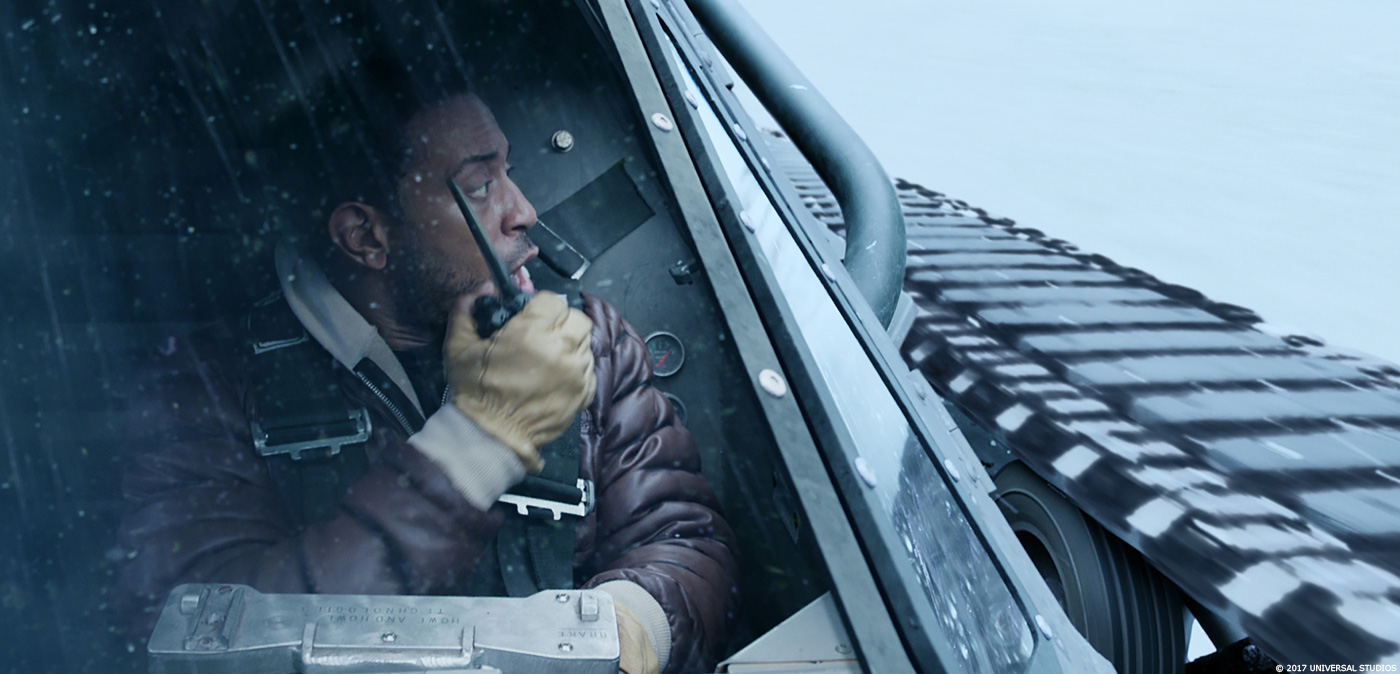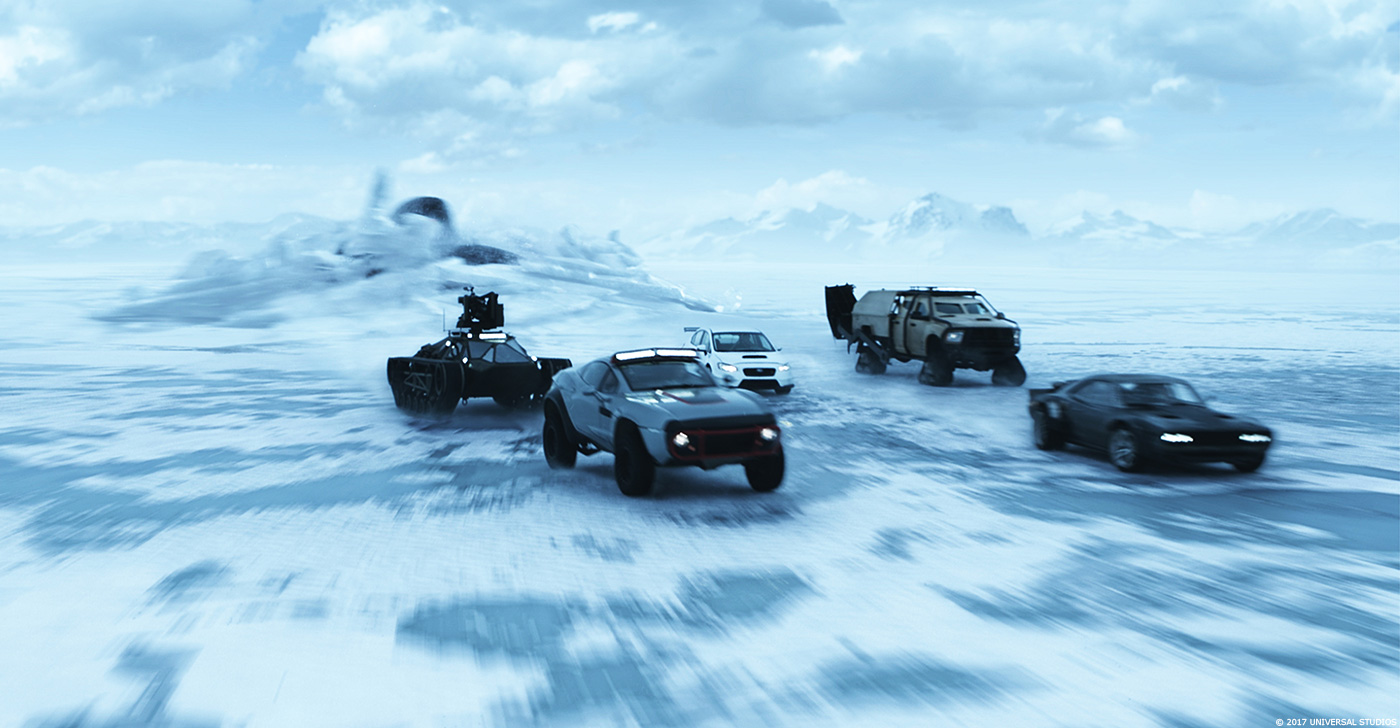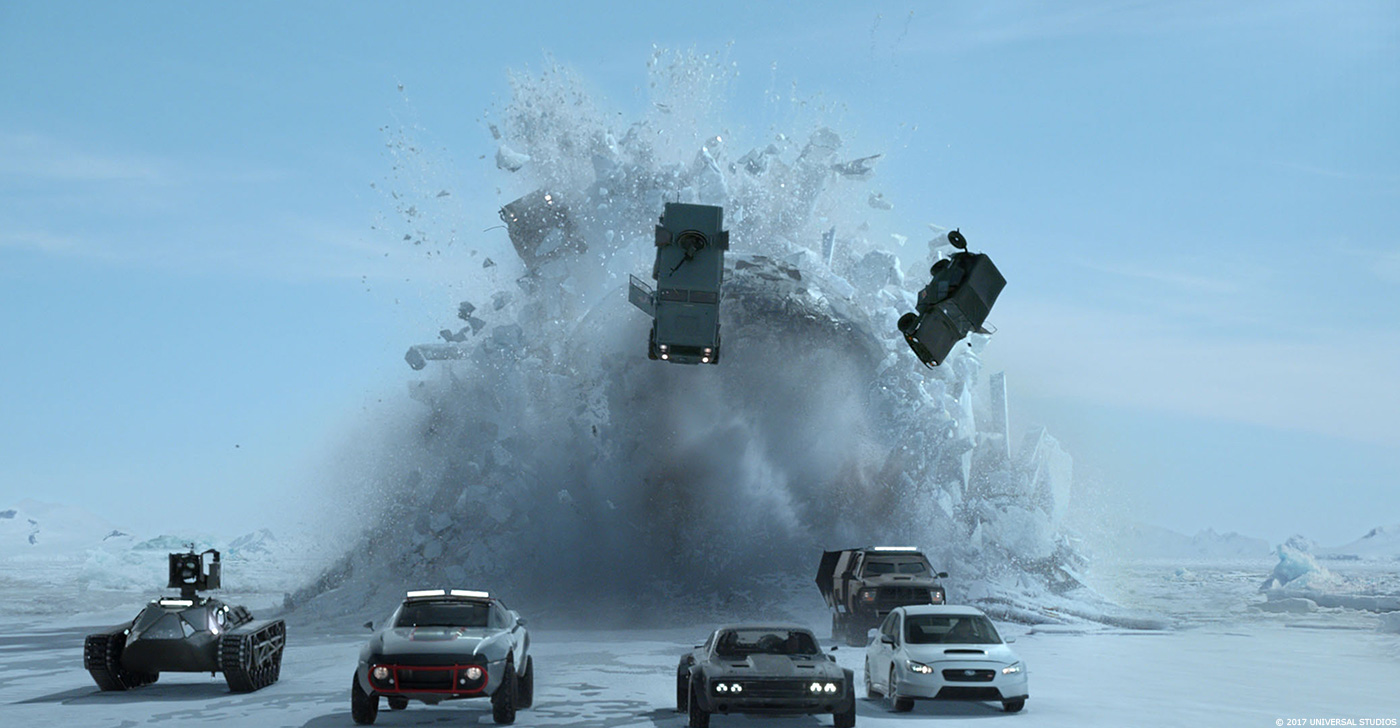In 2012, Jay Barton explained to us the work of Digital Domain on ROCK OF AGES. He then worked on 47 RONIN, INTO THE STORM and FURIOUS SEVEN.
Nikos Kalaitzidis began his career at Digital Domain in 1995. He has worked on numerous projects such as TITANIC, THE CURIOUS CASE OF BENJAMIN CUTTON, TRON LEGACY, 47 RONIN and X-MEN: DAYS OF FUTURE PAST.
What was your feeling to be back in the FAST & FURIOUS universe?
Jay Barton – VFX Supervisor // These films are as much of a rush to work on as they are to watch. The pressure is always on to ratchet up the action and spectacle from the previous movies.
Nikos Kalaitzidis – DFX Supervisor // We knew it was going to be a crazy ride, and we were looking forward to the ice sequence in the third act of the film knowing it had to UP the VFX in the last movie, FURIOUS SEVEN. Now we’re speculating the FX Fast9 will have to top this one.
How was the collaboration with director F. Gary Gray and VFX Supervisors Michael J. Wassel and Kelvin McIlwain?
Jay Barton – VFX Supervisor // It was great. There is always a mix with movies of this size. Some sequences which require careful planning with stunts, art department etc. are like paint by numbers. Early on the look is set so all the departments can do their jobs. Other parts of the film may exist purely as a mention of wanting to see the coolest “X” we’ve ever seen and we get a lot of latitude to develop cool environments or effects. Sometimes we can go a little off the map, but its always fun working with the guys to expand the F&F universe.
Nikos Kalaitzidis – DFX Supervisor // Early in the show Mike and Kelvin thru down the gauntlet for the VFX on F8 demanding to hit a high bar making sure all our shots needed to be photo-realistic.
What was their approaches and expectations about the visual effects?
Jay Barton – VFX Supervisor // For all of the larger than life spectacle of the stunts in this franchise there has always been a basis in live photography. Even when a stunt or sequence has become fully CG many times there is something that has been shot… a plate, a vehicle, a reference, and everyone is always trying to capture that essence to root it in the physical. We always talk about how we would shoot something even when filming would be completely impossible.
The action is moving over the ice. Can you tell us more about the filming for this part?
Jay Barton – VFX Supervisor // There were main 3 types of shooting for this sequence. Wides and stunts were filmed on a large frozen lake (Lake Myvatn) in northern Iceland. The majority of action shots were filmed over about a month on the frozen lake. Due to a storm that came in right at the beginning of filming the ice never quite looked the way we had all hoped it would. This necessitated moue more replacement of the environment in CG than originally expected. The way the vehicles behaved dynamically on the ice was priceless though. A majority of the explosions were filmed on a smaller ice covered body of water that had originally been used for industrial purposes (i.e. no fish or wildlife). This allowed explosions to disrupt the ice and water as well as the vehicles such as the sub breach sequence. THAT was an exciting shoot! The third part was on a very large blue screen set back in Atlanta. Here we had the controlled environment tot shoot the main actors inside their cars. Custom rigs were made to toss the cars around to match the action shot in Iceland for all those signature hero dialog shots.
There are many crazy stunts during this sequence. Can you tell us more about it?
Jay Barton – VFX Supervisor // The stunt crew on this film was really exceptional. The things they pulled off in such extreme conditions were hardly to be believed, and I was there! That said, sometimes editorial is able to create sequences almost out of thin air by using parts of action in new ways. Some of the most fun we had in this sequence was creating all CG shots to tie all the pieces together. The cars riding on top of the submarine was such a sequence. That was not part of the original stunt photography. We were able to work with Universal to develop “the roller coaster” as it was called to tie into the surrounding live action and create a pretty unique and memorable mini sequence.
Which stunt was the most complicated to enhance and why?
Jay Barton – VFX Supervisor // Definitely the sub breach. We got a tremendous amount of action and detail from the live action explosion. Unfortunately it did not take up the volume, especially from the side, that a sub of that size would. The practical elements were also completely volumetric in nature. All that ice, snow and water kicked up needed a giant submarine mixed into it. That necessitated art directable sims to exactly match the practical elements in order to blend between everything seamlessly.
How long have you worked on this show?
Jay Barton – VFX Supervisor // I was on the show for a year and 3 months or so. I was involved with the second unit tech scouts prior to filming all the way through final delivery.
Nikos Kalaitzidis – DFX Supervisor // I worked on the show since August 2016-March 2017(delivery).
How did you organize the work at Digital Domain?
Nikos Kalaitzidis – DFX Supervisor // We broke up the 3rd act in 3 different mini-sequences with 3 different teams at DD:
1. Russian Submarine Base sequence: Dom drives up to the base and sets off the Electromagnetic Pulse
2. Submarine Ice Chase and Ice Breach sequence: Separatists chase our heroes onto the ice sheet when later the submarine breaches the ice and pursue our Fast8 cast, we referred to these shots as our roller-coaster sequence.
3. Submarine Kill sequence: Dom leads the heat guided missile to the submarine’s demise.
How does your experience on the previous FAST & FURIOUS movies helps you to prepare this new episode?
Nikos Kalaitzidis – DFX Supervisor // The most vital thing was to establish the same visual language along with the filmmakers. We knew it would take a bit of time to come up with the look of the base, the snowy environment, the ice sheet, etc… Once we formed these set of visual rules, we knew we’d be able to push out the volume of shots in the time we had left in production.
How did you approach and pre-viz this big final sequence?
Nikos Kalaitzidis – DFX Supervisor // We would initially start off animation to match the provided pre-vis from our clients. In most cases this was straight forward, with the exception of 50+ shots of which included the nuclear submarine plowing through the ice pursuing our heroes driving on the ice sheet, many of these shots were referred to as the Roller-Coaster sequence. Animation had to match close to the previs, hand off to our FX department who would use the anim to simulate the breaking icesheet and pass the simulation back to anim to fine tune the animation of the cars slipping and sliding on the simulated plowing ice before passing it to lighting department for final renders and back to FX for secondary simulations such as the volumetrics, ice chunks, snow particulates, clumps and simulated water and fire. Many of these shots consumed as an approximate average of 400, 000 proc hours between all the departments before delivering it to Compositing.
Can you explain in detail about the creation of the Russian submarine base and its icy environment?
Nikos Kalaitzidis – DFX Supervisor // We initially received conceptual artwork from our clients on the look of the Russian Separatist Base. Our Enviro team took the lead in laying out the blueprints for the base determining the snowy mountains, roads, buildings, factories, de-commissioned submarines, ships, cranes, docks and props all needed to make this Base. We had all hands on deck helping our enviro team with modeling, texturing, look-dev lighting and even using FX to procedurally create snow on all the top surfaces of each of the assets. The ice sheet was created using procedural shaders via Vray with different settings for rough or smooth ice, wind blown dunes of snow and combinations of each.
How did you created the various cars and especially the submarine?
Nikos Kalaitzidis – DFX Supervisor // The submarine was an Russian Akula class. Both the sub and the sub-dock was partially built on set and photographed with the talent. We were able to record set data of the set and receive lidar to precisely match our CG models to live action. Once we completed our CG submarine, we sent it to our clients for approval. Director F. Gary Gray kicked back the design of the Akula asking us to make the ship more evil. We ended up re-modifying the tail of the sub to look more diabolical.
The cars themselves were also the talent in the film and we wanted to make sure we added the right amount of detail to make it look as real as they were on set as well as adding the certain specifications to the CG rig for the animators to use for secondary animation, an example would be suspension or the flex in the ripsaw’s (tank) treads. The CG hero car’s built were as follows: Dom’s charger, Roman’s Orange Lamborghini, Letty’s Rally-fighter, Tej’ Ripsaw, Hobb’s Snowplow, Little Mr. Nobody’s Subaru and, of course a number of bad guy Separatist vehicles and helicopters.
Can you explain more about the water simulation and the various FX destructions?
Nikos Kalaitzidis – DFX Supervisor // In our ‘Submarine Kill’ sequence, Digital Domain had 22 shots that included large scale fire and explosions. 2nd unit had filmed an elaborate set of pyro used in many of our final comps. Many of these live action elements were combined and enhanced using SideFX’s Houdini FX simulated fire and explosions. The FX artists were able to quickly simulate and iterate using low resolution simulations for scale, timing and art direction. For final renders, FX were able to export volumetric data structures to our lighting department, using Vray, to be used for reflections and shadow in our final lighting of our vehicles and ice sheets. There were many shots our simulated rendered pyro matched 1 to 1 with the live action pyro, however, we were able to sprint to the finish line much faster due to the fact we had the on set photographed pyro for the use of previs, postvis, and most importantly reference for the FX & comp artists to match to in regards to scale, speed and heat!
Was there a shot or a sequence that prevented you from sleep?
Nikos Kalaitzidis – DFX Supervisor // The Roller-coaster sequence produced some tossing and turning in be! It was certainly challenging due to the fact we have never seen a submarine chasing cars thru an ice field and wanted by all means to avoid making this feel like a miniature.
What is your best memory on this show?
Nikos Kalaitzidis – DFX Supervisor // Looking back now, because of the great team we managed to gather at Digital Domain, we were able to keep the mood in the Screening Room as jovial as possible, no matter how late or early in the morning it would be, laughing with the crew and with whatever challenges we had to cope with, every time.
What’s the VFX shots count?
Nikos Kalaitzidis – DFX Supervisor // 775 Finals Delivered to Universal Studios.
What was the size of your team?
Nikos Kalaitzidis – DFX Supervisor // We had 300, artists and production crew combined, working at peak capacity, however over 400 people had worked on our sequences throughout the life time of the show. These teams were working in facilities in Vancouver, British Columbia, Canada and Playa Vista, California.
A big thanks for your time.
// WANT TO KNOW MORE?
Digital Domain: Dedicated page about THE FATE OF THE FURIOUS on Digital Domain website.
© Vincent Frei – The Art of VFX – 2017








